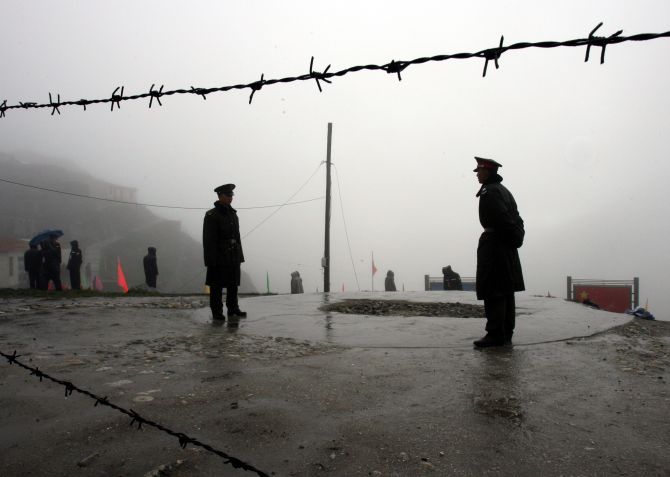The choice of Dhoka La for the intrusion by Chinese troops is significant and suggests a twin objective of pressuring Thimpu to allow Beijing to establish an embassy there and reinforcing Chinese claims on Arunachal Pradesh, warns former RA&W officer Jayadev Ranade.

Strategy, sovereignty and territorial interests are all at play in the stand-off currently underway between Chinese and Indian troops.
After nearly a decade, Beijing has chosen to reactivate the border with India in the Sikkim sector in the Dhoka La area in the tri-junction between India, Tibet and Bhutan.
The face-off has now continued for over ten days with two flag meetings at the border failing to resolve the issue and defuse tension and both sides building up their troop strength in the area.
In contrast to previous such occasions, this time statements emerging out of Beijing contain escalating rhetoric suggesting that China is hardening its position.
The timing of China's intrusion, which coincided with Prime Minister Narendra Modi's first meeting with US President Donald J Trump in Washington is, at the least, a convenient coincidence.
China has long been concerned about India's warming ties with the US and, with an unpredictable future for Sino-US relations under Trump, Beijing's worries will have increased.
This was reflected in the article in the State-run Global Times on June 26, 2017, which actually warned that close Indo-US ties 'could even lead to catastrophic results'.
The newspaper cautioned India that if it ceases to be non-aligned and 'becomes a pawn for the US in countering China, it will be caught up in a strategic dilemma and new geopolitical frictions will be triggered in South Asia'.
It advised New Delhi to 'avoid being roped into a geopolitical trap', adding that 'despite its anxieties over China's rise, maintaining a stable relationship with China is of more importance to its security and development'.
Another article in the Global Times also on June 26, sought to make a link between the Dalai Lama and the pilgrimage to Kailash Mansarovar.
Reacting to reports that China had stopped 50 pilgrims from travelling through Nathu La to Kailash Mansarovar, the Global Times tried to portray that China's actions are not aimed at ordinary Indian pilgrims and that India was to blame for the suspension of the 'yatra'.
The newspaper claimed 'China has always been open-minded on Indian pilgrims and will not indiscriminately prevent them from entering even if Sino-Indian ties are strained over the 14th Dalai Lama's visit to India' (sic).
Interestingly, the article quoted Zhu Weiqun, currently chairman of the ethnic and religious committee of the Chinese people's political consultative conference and formerly executive vice minister of the Chinese Communist party central committee's united front work department, which handles matters relating to Tibetans and China's other ethnic minorities.
Since his term in the UFWD, Zhu Weiqun has been assessed to be a hardliner on matters relating to Tibetans and the Dalai Lama.
The Global Times article quoted him as saying 'Despite China's efforts for improving passes for pilgrims, India has added difficulties for pilgrims to guard against China.'
It was in 2003, during then prime minister Atal Bihari Vajpayee's visit to Beijing that China agreed to accept Sikkim as part of India.
In accordance with the agreement the first official maps published by China thereafter, which was only in 2006, depicted Sikkim as part of India.
But within months the number of intrusions by China's People's Liberation Army in northern Sikkim increased.
At least 75 intrusions by PLA personnel were reported in 2007.
In 2008, when India's external affairs minister visited Beijing the Chinese vice foreign minister informed him that Sikkim was not a settled issue, thus casting doubt on China's credibility and indicating that China would not abide by the agreement signed between the two countries.
The present face-off appears to confirm that.
The choice of Dhoka La for the intrusion by Chinese troops is significant and suggests a twin objective of pressuring Thimpu to allow Beijing to establish an embassy there and reinforcing Chinese claims on Arunachal Pradesh.
Dhoka La is on the tri-junction between India, China (Tibet) and Bhutan.
China has been trying to build a road through Bhutanese territory, to which Thimpu has objected, up to Gyemochen, which is towards the lower end of the tri-junction.
China claims Gyemochen is the tri-junction between India, China (Tibet) and Bhutan whereas Survey of India maps of 1956 show Batang La, north of Gyemochan, as the tri-junction.
The difference of 18 kms would affect the claims of both countries regarding the border with reference to the McMahon Line, which Beijing describes as 'illegal' beyond Myanmar.
The ongoing Chinese action needs to be viewed in the backdrop of China's growing assertiveness over the past decade and the strain in Sino-Indian relations particularly since 2015.
China's official media articles surrounding the ongoing incident at Dhoka La also reflect Beijing's ire at India's unwillingness to acquiesce to the China Pakistan Economic Corridor or One Belt, One Road, thus putting at risk both these strategic initiatives.
Jayadeva Ranade, former additional secretary in the Cabinet Secretariat, Government of India, is President of the Centre for China Analysis and Strategy.
IMAGE: Chinese soldiers at the border with India at Nathu-la Pass in Sikkim. Photograph: Desmond Boylan/Reuters










